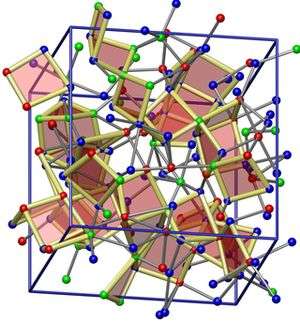April 15, 2008 feature
Atomic-Level Mechanisms of Phase-Change Memory Materials Revealed

Scientists from the University of Cambridge in the UK have uncovered the atomic-level interactions that occur when a class of “phase-change” memory materials stores information. Their work, reported in the March 23 online edition of Nature Materials, may open up new avenues for research into these fascinating materials, possibly leading to a new generation of “super” memory materials for electronic devices.
The materials studied are each composed of the elements germanium, antimony, and tellurium (Ge, Sb, and Te). They are used in devices that can retain information even when powered off, such as rewritable optical DVDs and a new type of electrical random-access memory intended to be a replacement for Flash memory, which is used in memory sticks, digital cameras, cell phones, and other portable devices.
The materials work by undergoing changes in their atomic structure. To store information, the structure rapidly switches from amorphous (disordered) to crystalline (ordered) in response to either an optical or electrical pulse. When the information is erased, the structured becomes amorphous again.
Despite many theoretical and experimental studies to understand the phase-change mechanism, the microscopic interactions have remained a mystery. This is due in part because the phase changes occurs so quickly, over only about one nanosecond, and the dimensions of the materials in the active regions on the devices are so small, only about 10 nanometers.
“For the first time, we have determined what goes on at the atomic level when one of these materials, Ge2Sb2Te5, stores information,” said University of Cambridge researcher Stephen Elliott to PhysOrg.com. “We have gained deep and valuable insight into this process.”
Elliott and co-researcher Jozsef Hegedüs set out to answer some basic questions about phase-change memory materials, including why the crystallization process occurs so quickly, taking only about one nanosecond, and why the process is so readily reversible.
They carried out a series of molecular dynamics simulations using computer software and were able to reproduce the entire Ge2Sb2Te5 read-write phase-change cycle. They modeled what would happen as the material was heated and then cooled rapidly or slowly, changing from a liquid to either an amorphous phase or a crystal, and then from amorphous to crystal upon reheating.
They found that, as the liquefied Ge2Sb2Te5 cools, very high densities of square-shaped molecular rings form, which persist even into the amorphous phase. The rings form the backbone of the crystal phase, serving as nucleation points for its growth.
“The significance is that this is the first time that the entire phase change cycle has been simulated by accurate molecular dynamics simulations, and that the role of the square rings in the crystallization process has been established,” said Elliott.
“Our approach may lead to the design of superior phase-change materials in the future, if we can find compositions, for example, that nucleate at much shorter times or at lower temperatures, and by investigating the effects of doping, such as with nitrogen. These properties could allow better memory devices to be manufactured, and more rapidly.”
Citation: J. Hegedüs and S. R. Elliott Nature advance online publication, 23 March 2008 (DOI 10.1038/nmat2157)
Copyright 2008 PhysOrg.com.
All rights reserved. This material may not be published, broadcast, rewritten or redistributed in whole or part without the express written permission of PhysOrg.com.





















